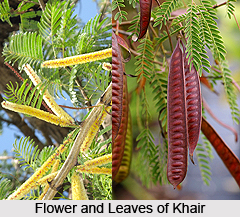 Khair is a moderate size deciduous tree with rough dark gray brown bark. It belongs to family "Leguminoseae-mimoseae". The tree of Khair is found all throughout India. The main areas for its habitat in the country are the eastern slopes of the Western Ghats and the Himalayan Regions. Khair is also used extensively in "Paan". Kattha, an extract of its heartwood, is used as an ingredient to give red color and typical flavor to Paan.
Khair is a moderate size deciduous tree with rough dark gray brown bark. It belongs to family "Leguminoseae-mimoseae". The tree of Khair is found all throughout India. The main areas for its habitat in the country are the eastern slopes of the Western Ghats and the Himalayan Regions. Khair is also used extensively in "Paan". Kattha, an extract of its heartwood, is used as an ingredient to give red color and typical flavor to Paan.
Khair grows well on all kinds of geological formations and soils, but porous alluvium consisting of sand and shingle suits it best. It grows on granite, gneiss, schist, quartzite, shale, basalt, trap, limestone conglomerate, laterite, etc. and also on black cotton soil.
Characteristic Features of Khair Plant
Khair is a small to medium sized deciduous plant. Khair grows slowly and matures to a height of about 10 meters in about 55 years. The diameter of the trunk is about 30 to 40 cm, and it is seldom straight. The leaves of this tress are bipinnately compounds with almost 50 pairs of leaflets which look like feathers. The bark of the tree is grayish brown in color that exfoliates into long and narrow strips. The flowers are generally cylindrical and sessile in shape and the colour is pale yellow in colour. The fruits or the pods are wide, flat, thin, brown and shining. Flowers in the plant are found in the months of June to August and the fruits ripen in the month of December to February. The sapwood is whitish yellow in color. The extract of the wood is cooled in moulds and the dried mass is broken into shinny jagged pieces for various uses.
Different Names of Khair
Botanically known as "Acacia Catechu", Khair has several regional names in India. For instance, it is known as "Khadira" in Sanskrit, "Black Catechu" in English, "Kher" in Gujarati, "Alagjaie" in Hindi, "Khadiram" in Malayalam, "Kaderi" in Marathi, "Bimbu" in Oriya, "Khair" in Punjabi, "Baga" in Tamil and "Kachu" in Telegu. Generally the plant is found in dry forest regions of the Indian sub-continent and in countries like Pakistan and Myanmar. It grows on almost all soil types and in areas which receive rainfall between 500 mm to 2000 mm. The plant is most common in central India and is a part of the deciduous forest in the states of Bihar, Rajasthan and Tamil Nadu.

Medicinal Values of Khair
The heart wood and bark of the tree are used in traditional medicine. A wood extract called "Catechu" is used in traditional medicine for sore throats and diarrhoea. The concentrated aqueous extract, known as khair gum or cutch, is astringent. It is used in Ayurvedic medicine. The astringent property of the bark and the heart wood of Khair are used in Ayurvedic medicine to treat leprosy, pruritis, wounds, bronchial asthma, distaste and stomatitis. The bark of Khair either alone or in combination with cinnamon and opium is used to treat passive diarrhoea or is sometimes taken internally to heal leprosy. Traditionally Kattha has been used in Indian medicine and is used in several compound preparations. Khair has a special astringent, cooling and digestive quality which is used to treat cough and diarrhoea. Sometimes kattha is used externally as an astringent and styptic lotion to relieve boils, ulcers and skin eruptions.
Other Uses of Khair
Khair has several traditional medicinal purposes but apart from the medicinal uses it has certain commercial uses. The wood of Khair being hard is used for making rice pestles, hookah stems, rollers for crushing sugarcane and oilseeds, ploughs, handles for knife, daggers and swords. The wood is also used for making quality charcoal which is eagerly sought by gold, silver and blacksmiths. While the wood is smooth and lustrous, and takes good polishing, it is not used in house construction because of superstition.
The khair tree is very useful in a number of ways. A pale yellow mucilaginous gum exudes from the tree, yielding one of the best substitutes for true gum. The wood extracts are used for tanning and dyeing khaki. Its heartwood extract is used as a preservative for fishing nets and as a viscosity regulator for oil drilling.
Cultivation of Khair Plant
The tree can be propagated by planting its seeds, which are soaked in hot water first. After about six months in a nursery, the seedlings can be planted in the field.











